Born and raised in the Inland Empire area of Southern California, Ramon joined the Army in 1993 before he had turned eighteen. He had always been “fascinated with aviation, military aviation in particular,” which led to his becoming a crew chief on Black Hawk helicopters. He was stationed first at Fort Hood and then in Korea. And he was deployed to Bosnia, which was still marked by war. After six years, Ramon felt it was time to try something else, so he left the Army and went to school to study animation. He now works as a 3-D animator at the Defense Language Institute in Monterey, California.
Vicky grew up in Cornwall, England. After graduating from university, Vicky trained as an ESL instructor and for several years taught English in Korea and Japan. As luck would have it, she and Ramon met in Korea, in a bar where English speakers congregated. Years later, news of the events of 9/11 caused them to get back in touch—and that’s when they realized there was something special between them. Vicky visited Ramon in California, Ramon proposed, and Vicky went back home to Japan, packed her bags, and made the move. One day, a palm reader on Venice Beach told her two unlikely things that did indeed come true: she was probably done with making money, and she would soon have two children.
Ramon and Vicky married in Las Vegas in 2002. In 2004 their daughter, Ellowyn, was born with severe disabilities. Her brother, Oliver, was born in 2006. Oliver’s birth was uneventful, and he came into the world as a typical baby boy.
During Vicky’s pregnancy with Ellowyn, she and Ramon took a class in the Bradley method of natural childbirth, and the day before Ellowyn was born “all the scans were normal.” But when Vicky went into labor at the hospital, she was told that the baby was positioned feet first, so she underwent an emergency C-section. At birth, Ellowyn weighed just over five pounds, and she had no ears.
EXCERPTS FROM OUR CONVERSATION
Vicki Topaz: When did you first notice that something was wrong with Ellowyn?
Ramon Lomeli: I heard the doctor say something about problems with her ears. They pretty much whisked her away straight to the neonatal intensive care unit. I barely got to look at her before they took her.
Vicky Lomeli: And they thought her arm was broken because it was blue. One side of her face didn’t move. Her birth was anything but normal. Ellowyn spent about six hours in the NICU. But she was doing so well that they said, “OK, she can go under the bili lights,” because she had pretty bad jaundice. They did all the tests for her heart and her kidneys, and the results all came back fine. When we took her home, we just thought, “Wow, she doesn’t have any ears. That’s awful. What are we going to do? Can she hear?” We didn’t even know if she could hear.
Can she hear?
V: No. She has no ear canals. There’s no hole, no nothing. But on the left side all the inner workings are intact. If there was an opening, she would probably be able to hear. The left side is kind of squished, and the inside is deformed as well.
Ellowyn has conductive hearing loss [which occurs when there is a problem conducting sound waves anywhere along the route through the outer ear, eardrum, or middle ear]. The sound doesn’t reach where it needs to go for her to hear . . .
R: When they put the bone-anchored hearing aid in, we had such trouble getting her to leave it alone . . .
V: It’s just a bolt that goes into her skull. She has a hearing aid that attaches to it that turns sounds into vibrations that she can hear, so it’s really effective.
R: It sounds like you have little speakers inside your head. When she’s wearing it, if I plug my ears and put my head to her head, I can hear what’s going on.
Tell me about Ellowyn’s legs and why she wears braces.
R: She has an extreme case of flatfeet, and her feet are turned out almost sideways. So when she walks barefoot, she’s almost walking on the fallen arches of her feet. The braces are to help her bones grow into the correct position.
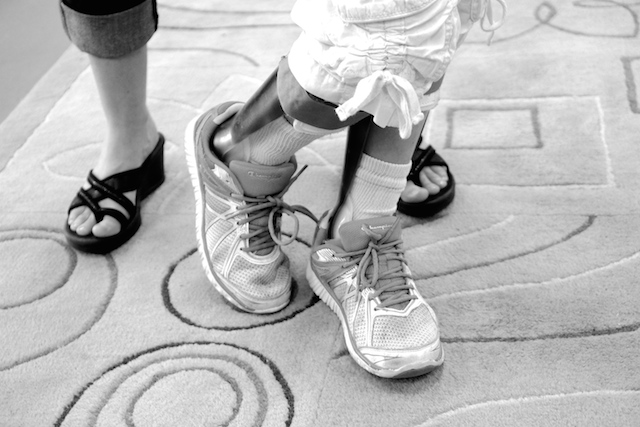
Braces help Ellowyn’s bones grow into the correct position.
Does she have problems walking?
V: Yes. She didn’t walk until she was about seven. She took steps when she was about four, but walking unaided was at about seven. It has something to do with the tone in her legs. She usually has very stiff legs. Physical therapy helps with that.
Do the doctors have anything to say about what might have caused the situation with Ellowyn?
V: No. They did a lot of genetic testing, but there’s no connection genetically—at least, that they can find. They say a switch didn’t get thrown during development or something. They have no idea. The syndrome that she has just happens. They call it Oculo-Auriculo-Vertebral syndrome. It means the stage in development when the switch that didn’t get thrown can affect her ears and her spine. OAV syndrome can also affect the heart and kidneys, but Ellowyn escaped that.
Did anything in the tests they ran when you were pregnant indicate that something was wrong?
V: No. But actually I think they probably saw something was wrong on the ultrasound. I don’t know how they couldn’t have, because her face is smaller on one side, and she doesn’t have any ears. I could probably see that on the ultrasound if I was looking for it, but no one said anything to us.
I know Ellowyn has seizures.
R: Pretty much the biggest medical concern with her right now is her seizures. They started in 2008.
V: We’d just moved to the coast, and she had a big seizure in the car. It was the first one we’d seen.
R: At first, I thought she was choking on something. I didn’t know what was going on. I pulled over to the side of the freeway, thinking, “She’s choking. Let me see what she’s choking on.” Fortunately, she didn’t let me get my finger in there, because I wouldn’t have gotten it back. Then we realized she wasn’t choking—she was having a seizure.
V: But I think she’d been having them before. We just didn’t know what they were. They weren’t your typical convulsive seizures. They were more like absence seizures. I think the onset was probably in 2007. We just didn’t know what we were looking at.
What do the doctors relate the seizures to?
V: It depends on which doctor you ask.
R: She’s been a bit of a mystery the whole time.
V: The technical term they use for it is multifocal seizure disorder, intractable, which means incurable. It means the disorder doesn’t react to medication.
R: Hence the plateau.
V: Yeah, we’ve run out of medications to try on her.
V: Our biggest fear, though, is that these seizures happen when she’s sleeping. So she always has someone with her. It’s very important that someone is with her.
R: And that’s where her service dog, Bravo, comes in.
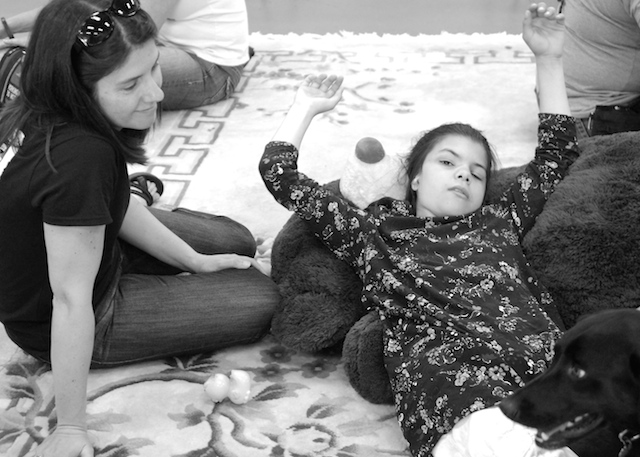
Vicky, Ellowyn, and Bravo.
OK, let’s talk about Bravo in a minute. When a seizure occurs, does she move around?
R: There is a tightness of her limbs. Her body goes rigid. She used to give a loud scream at the beginning of every seizure, and that would wake us up. We would go and turn her on her side so she’d have a clear airway, because she sleeps on her belly. She doesn’t use a pillow. She just has her face on the mattress, and usually she’s turned to the side. But when she’s having a seizure, we’ve gone in there and she’s been facedown on the mattress. I pick her up and turn her over just enough to clear her airway and then let the seizure run its course.
For the past few months now, she hasn’t been giving us that warning scream, so we don’t know when she has a seizure . . . We’re afraid of SUDEP—sudden unexpected death in epilepsy. Nobody really knows what that’s all about. But my theory, at least in Ellowyn’s case, is that it’s because she’s facedown on the mattress and she can’t breathe and her body can’t take over on autopilot and make her roll over. That’s our biggest fear, her suffocating.
V: We just saw seizures as the typical convulsive seizures—where the person passes out—because we didn’t have any experience. But before that seizure she had had episodes at school that were just unusual. She was throwing up. She was waking up during the night. One time when she woke up she looked like she’d had a stroke. She couldn’t sit up . . . We didn’t know what it was. If we had known before, we could have said, “OK, we need a neurologist.” But we just didn’t know. In a way, that first big seizure was good because it made us realize what was happening. She’s been having seizures since the age of four, and now she’s twelve.
So they continue?
V: Yeah, they’re . . . they’re not going to stop.
It sounds like Bravo is a service dog for all of you . . .
R: Well, not exactly. He’s Ellowyn’s seizure alert dog, which gives us peace of mind, especially at night. He’s there for Ellowyn, and that’s something that I had to come to terms with in the beginning. I was like, “Dude, focus on Ellowyn.” But dogs are pack animals, and Bravo’s accepted us as his pack. So he does triage: whoever needs it the most, he’ll go and comfort them. But he is Ellowyn’s service dog. He tells us when she’s having seizures. That is his primary mission.
V: Bravo’s not pushy. He’ll keep himself in check. And now, especially when Ellowyn’s going to have a seizure, he licks her and jumps on her—he’s a little more forward. Normally, we hear him get out of her bed because her bed creaks. That’s what wakes me up. He comes into our room to get us.
R: We have a baby monitor—the poor girl never gets any privacy. There’s a camera on her bed, and the baby monitor’s right there while we’re hanging out in the living room or when we’re sleeping. But a few weeks ago, she had a seizure late in the evening, and we didn’t hear anything at all.
Ellowyn was sleeping?
R: She was asleep. The monitor was turned to high volume, and we didn’t hear a thing. We didn’t even hear Bravo come out of the bedroom. He just came out to us in the living room—he only comes out to get us if she’s having a seizure. Later that evening she had a seizure. Bravo seemed to have predicted it hours in advance.
Where is Ellowyn in terms of learning, and how does she learn?
V: She functions cognitively at about eighteen months to two years, but that’s not to do with her hearing. That’s another thing that was going on, which we didn’t realize until she didn’t reach any milestones. Nothing was on time. Eventually, we figured out that something else was going on.
There are children who don’t have ears, and they learn just fine. They keep up. But not Ellowyn. And she wasn’t walking. She wasn’t making any effort to communicate. When babies are born, they usually fist their hands up, but they eventually open them and want to touch stuff. She didn’t do that at all. She didn’t want to be hugged. She was content, but she didn’t want you to hold her or hug her, which was really awful. I couldn’t understand why. At first we didn’t realize there was anything wrong. But when your baby doesn’t want you to hug her, it’s just weird.
R: She’s not like that now.
V: No, now it’s the opposite—she’s really affectionate. We didn’t know anything about milestones for kids. We read books and things, but everyone says, well, they reach milestones at different times and girls are different from boys. But she just wasn’t hitting any milestones.
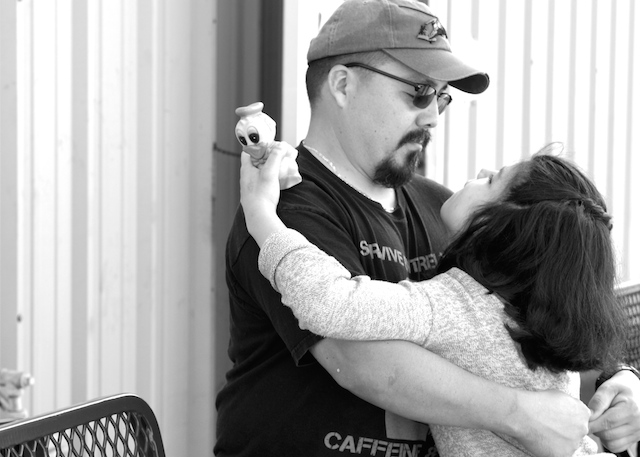
Ramon and Ellowyn.
What milestones were you looking for?
V: Picking up a toy or being curious about objects around her.
R: Or moving around. She was late to move around. We had so much thrust at us from the hearing-impaired community and hearing-impaired support services because everything was focused on her hearing. It took a while for us to realize that there were problems with other milestones, too. She wouldn’t pick up a cup. She wouldn’t pick up her food. She wouldn’t let you hug her. We only realized later that these were red flags.
And when you realized that there were problems, who did you reach out to for help?
V: This was when we lived in Los Angeles, when Ellowyn was under two. I think it was Early Intervention Services through the school district that gave us advice and sent us to physical therapy and occupational therapy. She got very good services. We learned what she should be doing and how we could help her learn to get these skills, like even crawling. She wasn’t crawling, picking up things, helping to feed herself. She was our first child, and we just didn’t understand what was happening. There were so many people wanting to help, which is great, but I was trying to be a first-time mom, and Ramon was trying to graduate from animation school. It was crazy.
With the help you were getting, did you start to see some progress?
R: Progress was slow.
V: But it was always forward. Everyone kept asking us if she ever regressed. She did regress with speech sounds, but that’s typical for kids with hearing loss. She slowly started to pick up other skills that she should’ve learned very early on but didn’t. Everything was a progression. It was just really, really slow. She makes slow progress in certain things. She’s learned to use a spoon pretty well. She’s learning to use a fork. She can pick up a cup and get herself a drink. She’ll feed herself by hand, no problem.
R: Most of it will go on her face.
V: Yes, but her aim is pretty good. She’s learned to tell us what she likes and what she doesn’t like.
By speaking?
R: By signing.
V: Yeah. I’m pretty certain she’s not going to speak. She has a voice. She laughs and she makes noise, but as far as words, probably not.
R: We’re kind of used to how things are now . . .
V: The first hearing specialist we met just after she was born told me, “Don’t think of her as broken. Because she’s not broken. She’s just Ellie.” And I thought, “You’re crazy. We’re going to fix her. We’re going to make her normal.” But no. She’s not broken. She doesn’t need fixing. She just needs a lot of help and people to get to know her.
R: It’s more like we needed to adjust to a new idea. She doesn’t need fixing. She’s fine like she is. She’s happy. She chows down. She’s communicative and affectionate in her own way.
V: She’s got a sense of humor. She’s mischievous. She sticks up for herself. She punched Oliver in the eye once because he upset her.
R: That’s a funny story—I have to tell it. We had just moved into our house, where the kids’ bedrooms are right next to each other. By that time, Ellowyn was walking and exploring, so we cordoned off where she can and can’t go. She’ll go and turn on the water in the sink. She’ll play in the toilet water. She’ll get into things. She used to pull stuff over. She’s not as destructive as she used to be, not that she meant to be destructive. She was just exploring.
But Oliver didn’t want her going into his room. One day when he was in there playing with his toys, he wanted to get her out of his room. But he was a lot smaller than her back then. He ended up pushing her over by accident—he didn’t mean to. She didn’t know, she didn’t care. Next thing from across the house I hear this loud “Raaaahhhhh!” She was screaming in anger. I go and investigate, and then I get the two of them together face to face, and I ask Oliver what happened. He explains things to me, and I get that it was an accident. That’s cool. But Ellowyn didn’t accept that it was an accident. She balled up her fist and wham!—she connected right with his eye, and then both of them were crying.
V: It was one of those perfect sibling moments.
R: And here I am, on the one hand saying, “Don’t hit your little brother” and on the other hand thinking, “Oh wow, she can stick up for herself. That’s awesome.” I didn’t want to make Oliver feel like it’s OK, but I was kind of impressed.
Does Ellie go to school?
V: She’s in a special day class. She goes to a regular elementary school, but it’s a special class where they have extra staff and a specially trained teacher. Ellie also has a one-on-one aide who is fluent in American Sign Language to help her. She is learning ASL very slowly, but it’s important that she’s exposed to it so that she can pick it up.
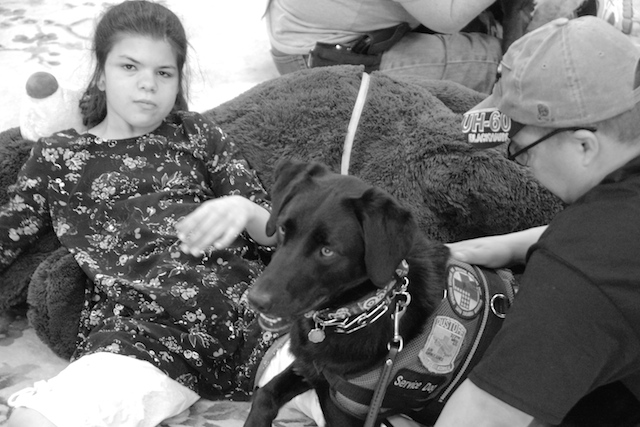
Ellowyn, her seizure alert service dog Bravo, and her father Ramon.
Was ASL something that was recommended?
V: It’s pretty standard for kids, especially nonverbal kids, to introduce ASL early on. It’s used even with kids who don’t have a hearing impairment. And she just seems to pick it up—again, very slowly. But it’s the only communication that she uses. She’ll use picture icons, but that’s a lot of work if you want to give her a choice of twenty items, for example.
R: In her class, she’s in moderate to severe with other kids of similar levels of learning disability and physical functionality. Most of them are on the same level.
V: Some of them are verbal. Some of them are learning sign with her because they like it. Some are physically fine but cognitively where she is.
Does she socialize with other kids at school?
V: A little bit. There are kids she clearly doesn’t like to be around, so she’ll move away. And there are kids she won’t play with but she’ll interact with a little bit. She much prefers adults as far as interacting.
Do you think that she likes going to school?
V: She loves it. She gets mad when we take her off the bus.
How often does she go to class?
V: Every day.
R: Her one-on-one aide helps her get cleaned up, eat her meals, and go to the bathroom.
V: Specifically, though, this aide was hired because she knows ASL. That’s what we’re trying to get Ellie to progress in.
Do you both sign?
V: Well, we know as much as Ellie. I know a little bit more because I’m Mum and I’m home.
What can she sign to you?
V: She signs “bathroom.” She signs “bath.”
R: And “cheese.”
V: She signs “eat.” She has approximations for a few signs that aren’t completely accurate, but you get to know them. She knows “bus” and “time for school.” She knows “good job.” There’s a lot more that she understands that she doesn’t use. But the signs she uses are the important ones like “eat” and “sleep.”
Does Ellowyn try to communicate in other ways, too?
V: Sometimes if I serve her something she really likes for dinner, she won’t start eating it until she’s bonked me on the head, because that’s her way of saying thank you. If I hang back and don’t do it, she tries to get closer to my head. She won’t touch the food until she gets the bonk.
R: Same thing when I’m helping her eat and she really, really, really likes something and she claps like she’s saying, “Come on, clap or I’m not eating.” I have to clap with her. I’m usually feeding her with one hand and trying to eat with the other hand, and she wants me to clap: “Come on, let me eat.” She has her rituals.
I can’t help but think of it as language.
R: She knows what she wants, and that’s how she tells us.
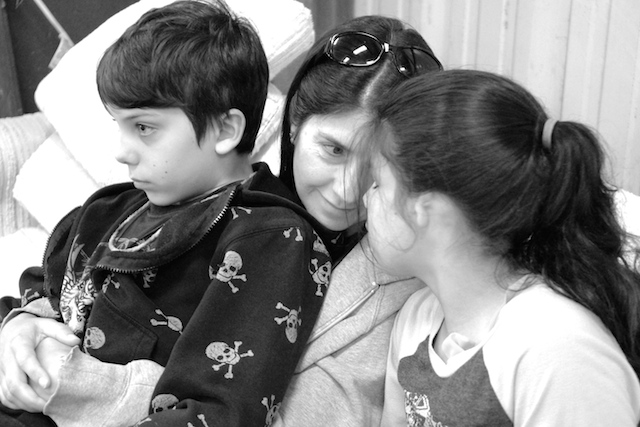
Vicky, Oliver and Ellowyn share a moment at training class.
How is Ellie with other kids and adults?
R: As far as socializing, I’ve noticed she tends to seek out more grown-ups for company. Not so much kids her age—although I saw her yesterday at school getting kind of chummy with one of the other little girls there, or at least having a staring contest or something. They sat right next to each other and they were looking at each other. They weren’t talking, but it almost looked like they were communicating in their own way. And then her aide told us another story. What was that boy’s name?
V: Chewie.
R: Chewie, yeah. I guess the two of them are clowning around during class—just messing around with each other, not paying attention. But when we hear those stories about Ellowyn’s playing with another kid, that’s cool.
Does Ellie respond to music?
R: If the music’s loud enough, she’ll hear it. I tend to play my music pretty loud. She really likes anything with bass.
V: She really likes music.
R: She’s a little raver girl in the making.
R: All of her favorite toys are the ones that make noise.
V: Loud noise.
R: She’ll put the toys up to her head so she can feel it.
She has a keyboard with a bunch of preprogrammed songs. Her favorite, every single time, is “Für Elise.” She’ll be playing with the keyboard and batting the keys and all that. And then I’ll put that song on autoplay, and she’ll just stop and put her head by the speaker on the keyboard and just listen to it. The song will loop and loop and loop, and she’ll stop what she’s doing for that song.
“Für Elise,” that’s Beethoven, right? Toward the end, he was composing after having gone deaf.
R: Yeah, that’s right.
Have you gotten to know some of the parents of other children with similar issues?
V: Some. It’s weird. Some of the parents are not inclined to get to know other parents at all. I have no idea why. Because I feel like we’re all in the same boat. I’ve handed out my e-mail address and my phone number to parents just so we can talk. But I’ve gotten zero response. I don’t know why.
I’ve had more luck online where you join a group of parents who are concerned with a specific condition, like epilepsy. It’s a not a big community, but it’s a very specific group. I’ve met a few people that way. Even if we don’t become friends, there is always support and advice and an exchange of information.
So you’ve got Ellie, and after a couple of years Oliver comes along. Was there an adjustment?
R: He’s never known any other way. He knows she’s not the typical kid, and in some ways he’s like her big brother. He looks out for her and takes care of her. And yeah, they still have their sibling squabbles and annoyances.
Yeah, but that’s kind of cool.
V: That’s as it should to be.
R: But he’s there when it counts. When we get up at night because Ellie’s having a seizure, more often than not he gets up and he’s there with us. One time he even wanted to sleep in her room. He pulled up his sleeping bag and said, “I have to stay here by Ellowyn in case she has another seizure.” He’s a very, very good brother to Ellowyn. We’re proud of him because no one asks for this. You don’t get to choose, but he’s taking it like a champ.
I sense so much love between you.
R: It’s just our normal. We laugh a lot because it’s better than crying. I’m the clown. Oliver gets his clowning from me, and sometimes he’s quite the ham. He’s a few grade levels up in his sense of humor.
V: And he’s very smart—scary smart sometimes.
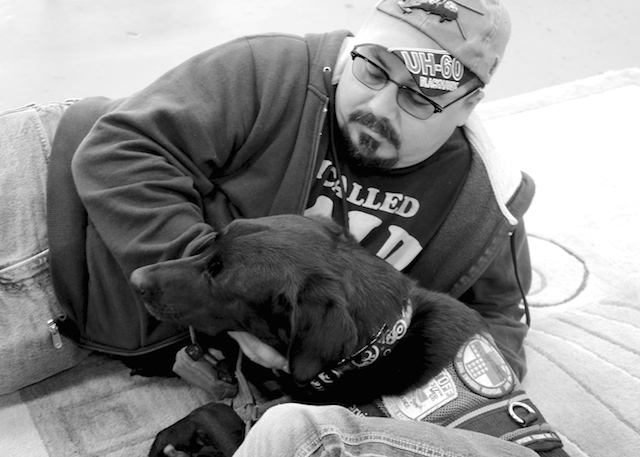
Ramon and Bravo.
How did you learn about service dogs? How did you come to have Bravo?
V: I work part-time for a nonprofit that takes care of adults with developmental disabilities. My boss is super: she’s really caring and wants to get to know people. When she met Ellie at a staff bowling event, she started telling me about her dog, a therapy dog. And she told me about the place where she trained her therapy dog. She said, “They have service dogs, too. Maybe you should look into that for Ellie.” I said, “There is no way we can afford a service dog”—you know, those $10,000 dogs. I just said, “It’s a nice idea, but we’re just not in the market for that kind of thing.” My boss said, “No, it’s free. But you have to qualify, and you have to commit for the year.” So I sent an e-mail to Operation Freedom Paws, the organization she was talking about.
OFP got right back to me. And so we went and watched a class and met Mary Cortani—the founder-director of OFP—who fell in love with Ellie right from the first day. It was so cool. But Ellie was just petrified. She did not like coming to OFP at all. It was a disaster!
How did you know that?
V: Because she would just snuggle into Ramon and wouldn’t touch anyone.
R: Mary was trying to introduce possible dogs to see what might work. Even with Clover, who’s very affectionate, Ellie started crying. Clover began licking me and Ellowyn all over, and Ellowyn started crying hard.
Do you think she was crying out of fear?
R: Probably out of fear and discomfort. But now she and Bravo sleep in the same bed. They’re totally cool. She’s not openly affectionate with him the way Oliver is, but she’s OK with him.
V: She didn’t look at anyone. She didn’t engage with anyone. I was just dismayed at that point and thought, “There’s no way.” When she’s afraid of something, that’s pretty much it. But Mary never gave up. She kept bringing out different dogs and trying different things, and eventually Ellowyn wasn’t afraid anymore. She started coming out of her shell. She wasn’t happy about the dogs being around her, but she didn’t freak out.
Why did Bravo work out for Ellowyn?
R: Mary picked him out. Mary was watching us and watching Ellowyn and trying different dogs . . . different dog colors, different dog sizes, some furry dogs, some not-so-furry dogs—just to see how Ellowyn reacted. Eventually she said, “You know what? Let’s try Bravo.” Bravo was the first dog that Ellowyn didn’t really have a meltdown with.
V: There was no fear. Ellowyn hardly even reacted. She was just cool with him being around, and he is so mellow.
Do you have any idea why she tolerated Bravo?
V: There was a change one day when they just let Ellowyn walk around as a distraction as the other clients were doing their training. Instead of the dogs coming up to her, she was able to go up to the dogs, and that seemed to be a turning point. She didn’t like dogs approaching her or being overly friendly. But Bravo isn’t like that. He’s very mellow.
R: He’s almost furniture.
V: Yeah. And he didn’t jump all over her. But because she had the opportunity to go to the dogs rather than the other way around, that seemed to help a lot. Then she was introduced to Bravo. It was perfect timing.
R: Well, I helped it along. We were getting introduced to Bravo, and he was hanging out with us. I noticed Ellowyn wasn’t crying or as afraid, so I thought, “OK, it’s time to get her out of her comfort zone.” I covered her in dog treats, and Bravo went over and licked her and she got used to it. And I put dog treats in her hand so Bravo would take them out of her hand.
There’s a mysterious animal-human connection, don’t you think?
V: There’s no good way to explain it. She didn’t go and hug him or pet him or anything, but she didn’t react in a negative way at all, and that was a big deal at that point.
What do you do in the OFP class?
R: Well, at first, we tried walking with Ellowyn and Bravo. It didn’t really work out, because at first we were going at the end of the day, and she was already tired. So then we tried putting her in her stroller and getting around that way. That’s how we did evening classes. And then Vicky would go during the day.
Eventually, it just got to where I needed to have one-on-one time with Bravo so I could learn how to handle him because it was distracting keeping one eye on Ellowyn and one eye on Bravo. Bravo and I would do the training exercises on the weekends, and Vicky would do that during the week. We started to get more comfortable with being handlers and getting more familiar with the do’s and don’ts. It’s important that Bravo is Ellowyn’s dog. I just happen to be a veteran, and we handle him for her because she can’t do it.
We made it work. Whatever we learned at OFP, we took it home and we did it that way. Eventually, we got to where there were situations where Vicky and I were both going to be away from Ellowyn and Oliver. And Oliver was getting bigger, and we figured he should be able to handle Bravo, too, as a backup. If we needed him in a pinch, he could take over for a little bit. So we started having Oliver do some training time in class. And he’s picking it up now, too.

Oliver, Ramon, Ellowyn, and Vicky.
It’s great to see Oliver in class and keeping up the training.
R: It’s helped Oliver, too, because he used to be petrified of dogs. Now that he’s been around them, he’s gotten used to them. He’s a lot more confident when he sees a strange dog. He knows how to act appropriately, not like kids who don’t know any better who run and try to pet it, which could agitate the dog. Oliver knows what to do and when to leave a dog alone.
Oliver, why do you like Bravo?
O: He’s fun, he’s cute, and he’s a friend I can play with. He’s funny, and he messes around with my cats.
Tell me about your cats.
O: They’re small. One’s fat, one’s skinny.
What are their names?
O: One’s Hobbes, one’s Twiggy.
I noticed today and last week that you were working with Bravo in the OFP class. What’s that like for you?
O: Not bad. It’s like my parents always say, “Every day’s a learning experience.”
#
RESOURCES | INFORMATION:
- ADA Requirements: Service Animals
- ADA Frequently Asked Questions
- Service dog and training provided by
Operation Freedom Paws - Photographs by Vicki Topaz.
